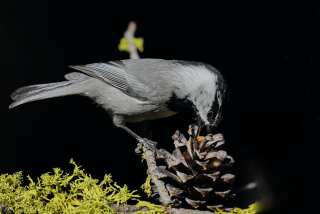AMERICAN ALBUM : Return of cicadas has Chicago area buzzing : After 17 years, the insects are back, creating some noise problems and spawning a few new recipes.
- Share via
PALOS HEIGHTS, Ill. — What’s a little slimy, predictable as taxes and slower than a refund, is often mired in dirt and seems to accomplish little more on this Earth than loiter, leech, have sex and raise an incessant, unintelligible earsplitting racket?
A congressman? Commodities broker? TV evangelist? Talk-show host?
OK, so it’s a trick question. The pest under discussion in this particular context is the Real McCoy, in its most recognizable form a big, strange, homely black bug with beady orange eyes of the genus magicicada . The 17-year cicadas are back, and all Chicago is buzzing about them.
“After you get over the grossness of them, they’re fascinating,” said Diane Pape, whose trim front lawn in this southwest suburb has turned into a graveyard for thousands of molted tan cicada skins. Her daughter, 8-year-old Jessica, gushed: “The last time they came out of the ground I didn’t even exist. I wasn’t even growing inside a tummy.”
Yes, Jessica, the last time the cicadas showed up around here, Richard Daley the Original was still boss of Chicago, Richard M. Nixon was twisting in the winds of Watergate, the world of nations included one called South Vietnam, nobody in his right mind bought a Japanese car and Madonna was a religious term.
Cicadas are the Rip van Winkles of the insect world. The nymphs burrow a couple of feet below ground, where they suck nutrients from tree roots as they slumber for a full 17 years (or 13 years, in the case of a strain with a little more get up and go).
Then, in late May or early June of their appointed year, a genetic alarm bell goes off and sends them wriggling to the surface by the billions. Seas of them ooze from the ground like something out of a science fiction movie and crawl to the nearest tree, where they hang on to the bark, split their outer skins and emerge as albino-colored winged creatures about 1 1/2 inches long. A few hours in the sunlight turns them black.
They mate, the males die, the females flutter around for three weeks or so and lay their eggs, then die themselves. The eggs soon hatch, and the nymphs burrow into the ground, repeating the cycle 17 years later.
Scientists admit that the process is puzzling even to them. “It’s really a strange thing of nature the way it all works,” said Robert Wolff, a biologist who leads cicada safaris for the Chicago Academy of Sciences.
Some cicada species hatch annually, but there are about 20 distinct broods of the 17- and 13-year varieties, all dispersed around the eastern United States. Three years ago, there was a major emergence in the Washington, D.C., area. This year, it’s northern Illinois, especially the leafy Chicago suburbs, and next year it will be the Ohio River Valley.
Records of such outbreaks date to the days of the Pilgrims, who mistook cicadas for locust plagues described in the Bible. The misnomer stuck, and for centuries cicadas were erroneously referred to as 17-year locusts.
In reality, cicadas are pretty harmless. The adults don’t have any teeth, so they don’t bite or chew through plants and leaves. Females like to lay their eggs in small twigs, so they do manage to kill off some weak saplings.
Still, some people are petrified by cicada invasions. A few years ago during an outbreak in Ohio, a Cincinnati truck driver lost control of his vehicle and crashed into two houses when a cicada flew under his glasses. That same year, two cicada-packing robbers thrust a bug in the face of a Cincinnati restaurant cashier, who fled. The men then helped themselves to $25 from the register.
To humans, if anything is at real peril from cicadas it’s peace of mind. Males tend to clump in choruses by the thousands and emit a screeching mating plea that approaches the decibel level of industrial plants. It can become so deafening that some people don ear plugs to block them out.
“I was on a phone today with someone in Oak Lawn, and I could hear her cicadas on the other end,” said Linda Danilwicz, who has thousands of cicadas to listen to in her own yard in Palos Heights.
The din from cicadas may be annoying, but a growing number of area residents--both man and beast--are turning on to the notion of cicadas as “din-din.” Dogs, squirrels, chipmunks, raccoons, skunks, ducks and birds of all kinds are gorging themselves on mouthfuls of cicadas.
And the University of Chicago, spurred on by experts who insist that the bugs are low in cholesterol and rich in proteins, carbohydrates and oils, has been promoting recipes for everything from using cicadas as a pizza topping to mixing them in salads.
For cicada stir-fry, mix two cups blanched, newly molted cicadas with one small chopped onion, two teaspoons grated fresh ginger root, one medium sliced carrot, one cup cauliflower florets, half a pound of snow peas, one cup bean sprouts and chopped fresh coriander leaves to taste. Stir-fry in oil until tender crisp and serve over a bed of rice.
Mmmmm, mmmmm, lip-smacking good.
More to Read
Sign up for Essential California
The most important California stories and recommendations in your inbox every morning.
You may occasionally receive promotional content from the Los Angeles Times.










